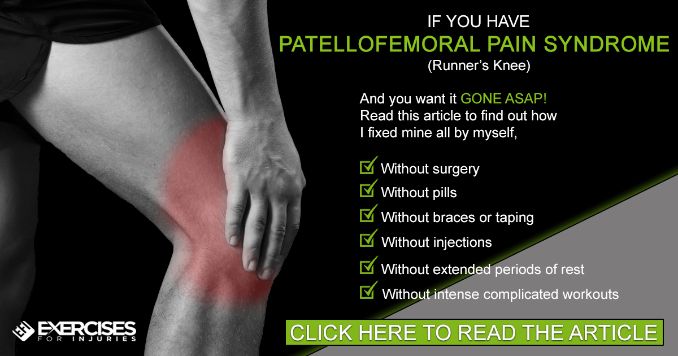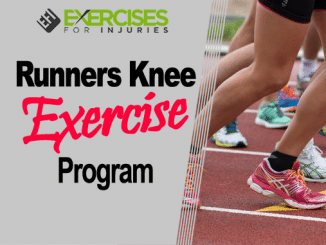
Patellofemoral pain syndrome (PFPS), also known as runner’s knee, can be frustrating and painful, especially for those who enjoy staying active. If you’re dealing with knee pain around the patella, I know how limiting it can feel. But don’t worry—there’s good news.
Patellofemoral pain syndrome exercises can help strengthen the muscles around your knee, improve mobility, and reduce pain, allowing you to stay active and regain confidence in your movement.
In this post, I’m sharing the top exercises for Patellofemoral pain syndrome that can help you relieve pain, improve flexibility, and strengthen the muscles around your knee. These exercises are gentle yet effective, and with consistency, they can help you get back to your regular activities without discomfort.
Before we discuss the exercises, let’s examine PFPS and why the right exercises are crucial in treating this condition.
1. Quadriceps Stretch For PFPS Relief
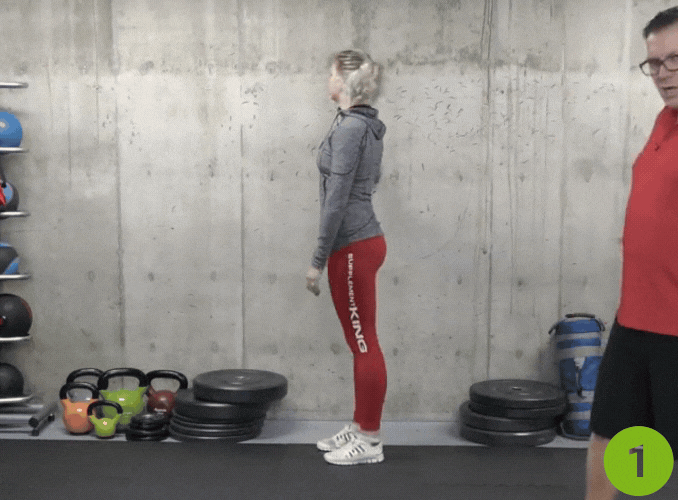
- Begin in an upright standing position beside a wall, maintaining good alignment with your head, shoulders, hips, and legs.
- Press one hand on the wall.
- Engage your core, bring your heel up against your seat, and hold your foot with your hand for support.
- Hold the position for several deep belly breaths, in through your nose and out through your mouth.
- Lower your foot to return to the starting position and repeat the movement on the opposite side.
Modification
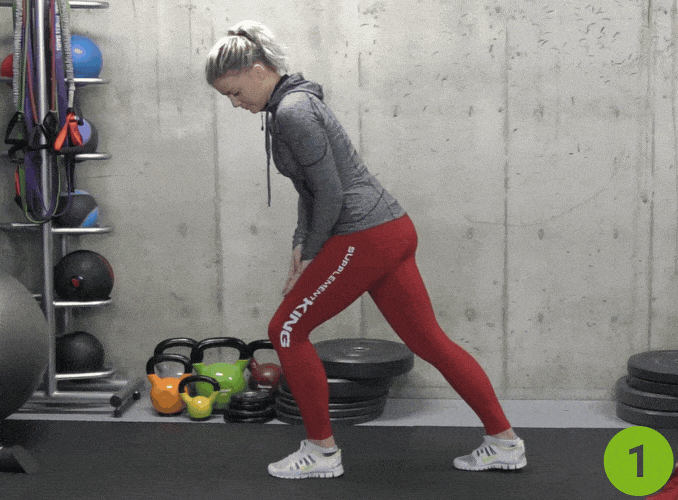
- Begin in an upright standing position beside a wall, maintaining good alignment with your head, shoulders, hips, and legs.
- Press one hand on the wall.
- Engage your core. Lift and bend one knee at a 90-degree angle.
- Hold the position for several deep belly breaths, in through your nose and out through your mouth.
- Relax and repeat the movement on the opposite side.
As we address the quads, the next step is to focus on improving knee mobility with a movement that further strengthens the muscles involved in knee function.
2. Standing Hip Flexors Stretch
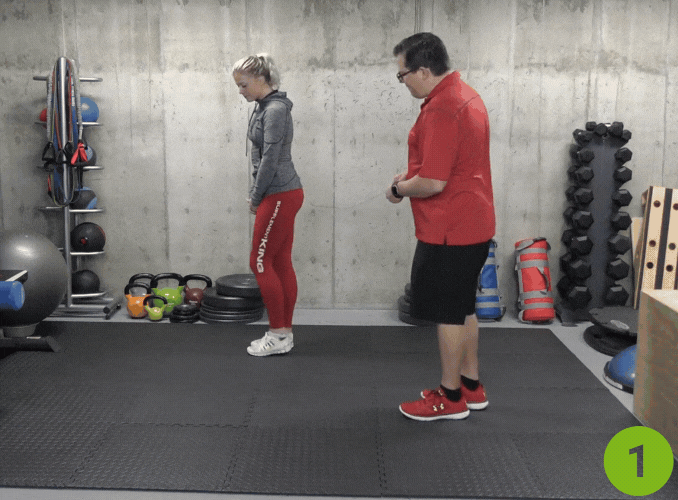
- Begin in an upright standing position with your feet hip-width apart, maintaining good alignment with your head, shoulders, hips, and legs.
- Engage your core.
- Take a step backward and bend your front knee to stretch your back leg.
- Place your hands on your front knee to keep your spine straight.
- Hold the position for several deep belly breaths, in through your nose and out through your mouth.
- Relax and repeat the movement on the opposite side.
Modification
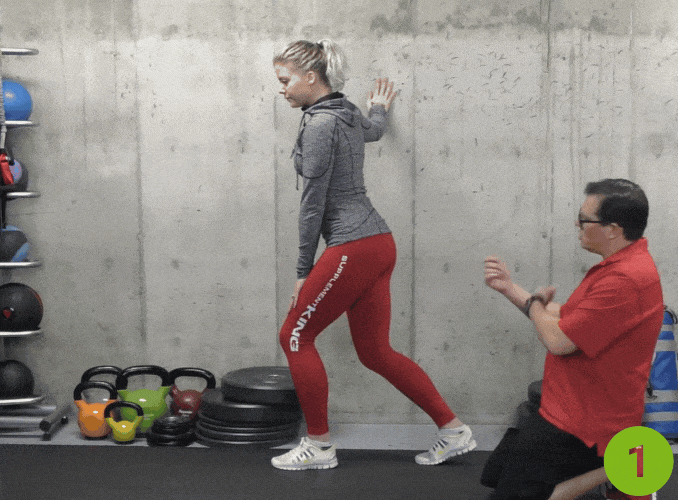
- Begin in an upright standing position beside a wall with your feet hip-width apart, maintaining good alignment with your head, shoulders, hips, and legs.
- Place one hand on the wall.
- Engage your core.
- Take a step backward and slightly bend both knees while keeping your spine straight.
- Hold the position for several deep belly breaths, in through your nose and out through your mouth.
- Relax and repeat the movement on the opposite side.
3. On Side Hip Back
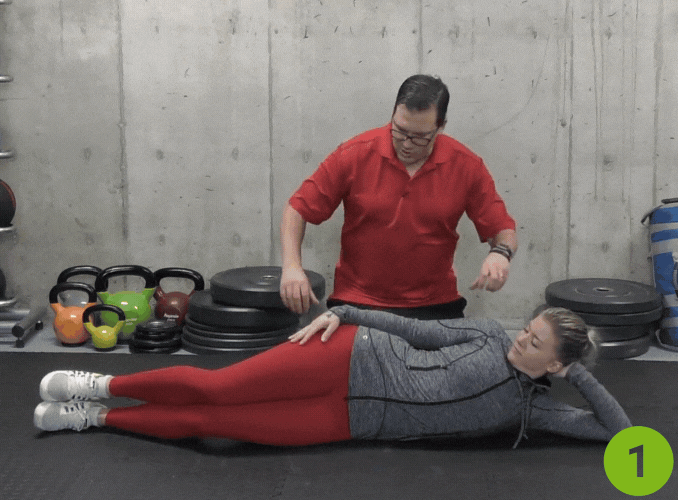
- Lie on your side with your legs slightly bent and stacked together, maintaining good alignment with your head, shoulders, and hips.
- Bend your bottom arm to support your head.
- Tighten your abdominal muscles.
- Bend your top knee in a 90-degree angle.
- Hold the position for several deep belly breaths, in through your nose and out through your mouth.
- Relax and repeat the movement on the opposite side.
Now that we’ve stretched the hip flexors, it’s time to target the muscles around the hip and thighs to improve strength and flexibility.
4. Sticking The Quads
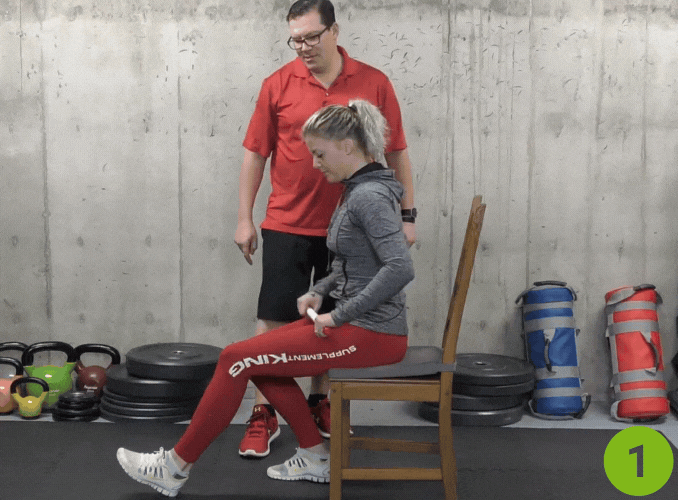
For this exercise, you need to use a massage stick.
- Begin in an upright sitting position on a chair with your knees bent and feet flat on the floor.
- Maintain good alignment with your head, shoulders, and hips.
- Engage your core.
- Step forward with one foot and start running the massage stick along your quad area.
- Repeat the movement on the opposite side.
5. Chair Hip Flexors Stretch
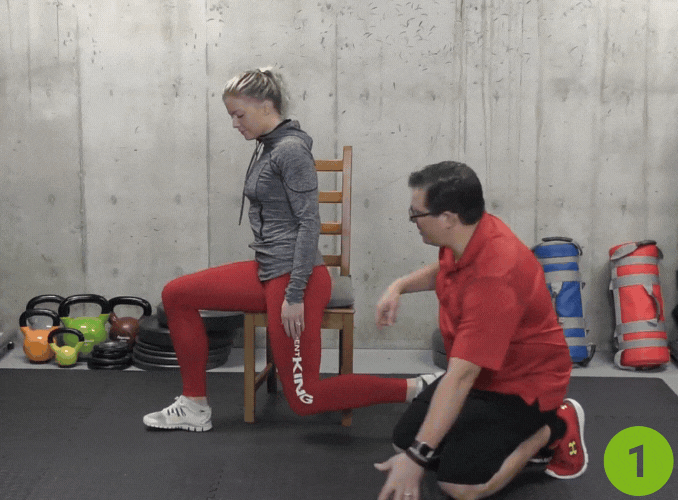
For this exercise, use a sturdy chair without wheels to ensure stability.
- Begin in an upright sitting position at the edge of the chair with your knees bent and feet flat on the floor.
- Engage your core.
- Lower one knee down to the floor, moving into a lunge position.
- Place one hand on your hip as you keep your back straight.
- Hold the position for several deep belly breaths, in through your nose and out through your mouth.
- Relax and repeat the movement on the opposite side.
6. Standing Knee Flexion
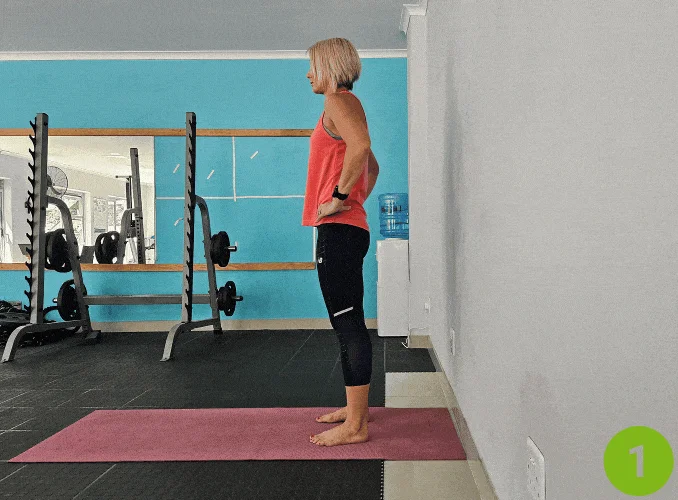
- Begin in an upright standing position behind a wall with your feet hip-width apart, maintaining good alignment of your head, shoulders, hips, and legs.
- Slowly bend your knee backward while keeping your foot flat against the wall.
- Aim for a 90-degree angle at the knee, if comfortable.
- Put your hands on your hips and engage your core.
- Lift your left heel off the wall and slowly drop your heel down, squeezing your glutes.
- After a few repetitions, return to the starting position and repeat the movement.
- Complete 2 to 3 sets of 5 repetitions on each side.
Building on knee mobility, let’s stretch the hip flexors—another key muscle group that alleviates PFPS symptoms.
7. Kneeling Hip Flexor Stretch
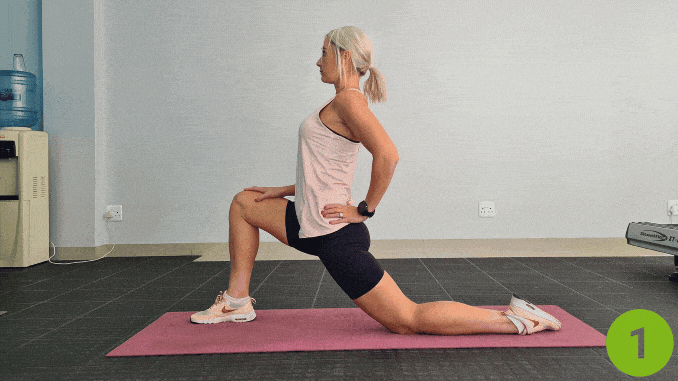
Tight hip flexors are often linked to PFPS, as they can pull the pelvis out of alignment, affecting the knee. This stretch targets the hip flexors to improve flexibility and reduce knee strain.
- Begin in an upright kneeling position on the floor, maintaining good alignment with your head, shoulders, hips, and knees.
- Step and bend forward your right knee at a 90-degree angle.
- Place your hands on your hips. Engage your core and move your hips forward while keeping your spine straight. Hold the position for several deep belly breaths, in through your nose and out through your mouth. Relax and repeat the movement on the opposite side.
Now that we’ve stretched the hip flexors, it’s time to target the muscles around the hip and thighs to improve strength and flexibility.
8. Hip Extension
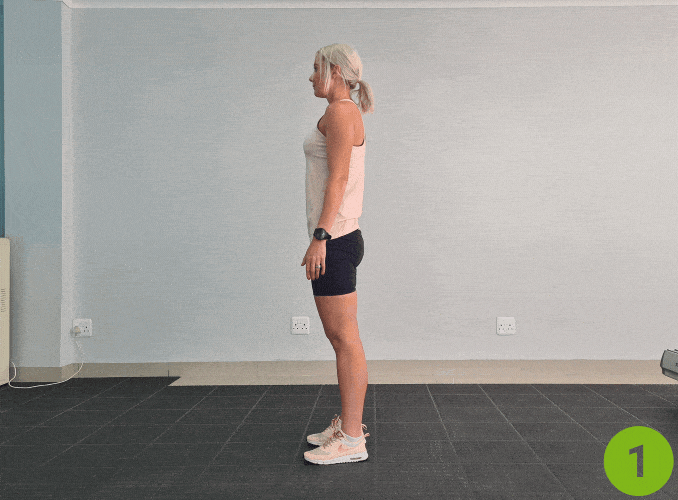
This exercise targets the quadriceps, thigh muscles, and hip flexors, three key muscle groups involved in knee function. Strengthening these muscles helps support the knee joint and prevents further injury.
- Begin in an upright standing position with your feet hip-width apart, while maintaining good alignment with your head, shoulders, hips, and legs.
- Place your hands on the sides.
- Engage your core and lift one leg straight behind.
- Hold the position for a couple of seconds.
- Then, lower your foot to return to the starting position and repeat the movement on the opposite leg.
- Complete 2 to 3 sets of 5 repetitions on each side.
Now that we’ve addressed strengthening and flexibility, let’s move on to an easy and effective self-massage technique to ease tightness in the quads further.
Building on self-care, let’s explore an alternative stretch that can be done without kneeling—perfect for those with more severe pain or limited mobility.
Understanding Patellofemoral Pain Syndrome (PFPS) And Runner’s Knee
Before discussing the patellofemoral pain syndrome exercises, let’s first understand what they are and why they are essential for managing this condition.
What Is PFPS?

PFPS refers to pain in the front of the knee, around the kneecap. It can occur due to misalignment, muscle imbalances, or overuse. It’s commonly experienced by athletes, particularly runners and those with repetitive knee stress.
Common Causes Of PFPS
PFPS often results from factors like weak quads, tight hip flexors, or abnormal knee tracking. According to esteemed consultant knee surgeon, Mr. Arman Memarzadeh, when there is an imbalance in the strength of muscles like the quadriceps and gluteal muscles, it can lead to maltracking of the patella, putting increased pressure on the knee joint. Understanding the cause of your knee pain can help you choose the right exercises for Patellofemoral pain syndrome to manage and reduce discomfort.
Symptoms Of PFPS
PFPS manifests through various symptoms, which often arise gradually and worsen with continued activity.
Knowing the common symptoms can help you recognize PFPS and begin addressing it with the proper Patellofemoral pain syndrome exercises.
- Pain Around the Kneecap: The most common symptom is pain in the front of the knee, especially around the kneecap. The pain can be dull or sharp and typically worsens with activities like running or climbing stairs.
- Knee Stiffness or Swelling: Stiffness may occur, particularly after sitting for long periods. Mild swelling around the knee joint may also occur.
- Pain with Prolonged Sitting (Theater Sign): A typical symptom of PFPS is pain when sitting with the knees bent for long periods, like watching a movie or driving.
- Crunching or Popping Sensations: Some people experience a popping or grinding feeling in the knee when bending or straightening the leg. This sensation is due to improper tracking of the patella.
Understanding the symptoms can help guide you toward the right Patellofemoral pain syndrome exercises to target and alleviate these discomforts.
Now that we’ve covered the causes and symptoms, it’s time to move on to exercises to help you recover and manage PFPS.
How Exercise Can Help
Targeted Patellofemoral pain syndrome exercises help strengthen the muscles around the knee, improve flexibility, and restore proper knee alignment. This combination reduces the strain on the patella and can prevent future flare-ups of pain.
With a better understanding of PFPS, strengthening key muscles and improving flexibility will be essential to reducing pain. Now, let’s explore how specific exercises for PFPS can help address these needs.
Why Exercises For PFPS Matter
When managing PFPS, it’s crucial to focus on exercises that stretch and strengthen. Strong quadriceps, hamstrings, and hip flexors help stabilize the knee and take the pressure off the patella.
Stretching, on the other hand, improves flexibility and relieves muscle tension around the knee. Together, these exercises create a well-rounded recovery approach, improving both strength and mobility.
As Dr. Kate Baldwin (PhD), a physiotherapist, researcher, and endurance athlete, explains, “Think of your glutes and quads as your knee’s support team. When they’re strong, they help keep your knee in line, reducing unnecessary strain on the patella and preventing pain from flaring up.” Strengthening these muscles is one of the most effective ways to manage and prevent a runner’s knee.
Now that we understand the importance of these exercises let’s examine the specific movements that can improve PFPS management.
Foot And Ankle Considerations
Foot and ankle problems can contribute to patellofemoral pain syndrome (PFPS) development. Abnormalities in the foot and ankle shape or structure can affect how the knee joint moves and functions, leading to increased stress and strain on the tissues surrounding the kneecap.
Some standard foot and ankle problems that can contribute to PFPS include:
- Flat feet can cause the foot to pronate or roll inward, increasing stress on the knee joint.
- Ankle instability: This can cause the ankle to wobble or give way, leading to increased stress on the knee joint.
- Tight calf muscles: This can cause the foot to point downward, leading to increased stress on the knee joint.
- Abnormalities in the foot or ankle shape or structure: This can affect how the knee joint moves and functions, leading to increased stress and strain on the tissues surrounding the kneecap.
Addressing any underlying foot and ankle problems is essential to effectively managing and treating PFPS. This may involve orthotics, physical therapy, or other interventions to improve foot and ankle function and reduce stress on the knee joint.
Common Mistakes To Avoid During PFPS Exercises
While these exercises are helpful, performing them incorrectly can lead to further injury.
Here are some common mistakes to avoid:
- Pushing Too Hard: Start slow and build intensity gradually. Overexertion can worsen PFPS symptoms.
- Ignoring Pain: Don’t push through sharp or sudden pain. Stop if you experience any discomfort beyond mild stretching or strengthening.
- Incorrect Form: Proper form is essential to avoid stress on the knee [2]. Make sure your knees are aligned, knees bent, and you’re using the correct posture during each exercise.
Having covered key exercises and potential mistakes, let’s now discuss when it might be necessary to consult a professional for more tailored advice and care.
When To Seek Professional Help

If your PFPS symptoms persist or worsen despite regular exercise, it may be time to consult a healthcare professional, such as a physical therapist. They can assess your condition, suggest tailored exercises, and ensure you perform them correctly.
Conclusion
Managing PFPS requires a balanced approach—strengthening key muscles, improving flexibility, and practicing proper technique. Incorporating these exercises into your routine can help alleviate pain and prevent future flare-ups. Remember, consistency is key; if the pain persists, don’t hesitate to seek professional advice. Keep going, and your knees will thank you!
If you want a more structured program for managing your PFPS, check out our Patellofemoral Syndrome [1] Solution for a comprehensive guide to knee health and pain relief.
If you want more information on how much imbalances can lead to Patellofemoral Pain Syndrome, check out Muscle Imbalances Revealed.
FAQ
How Can I Heal PFPS Fast?
Rest from activities aggravating the knee, and focus on strengthening and stretching exercises. Use cold packs, compression, and elevation to reduce pain, and consider ibuprofen to ease inflammation.
What Muscles Are Weak In PFPS?
PFPS is linked to weakness in the hip abductors, particularly the gluteus medius and minimus, which affect knee alignment.
Does Taping Help PFPS?
Yes, patellar taping can reduce pain and improve knee mechanics, but it should be paired with strengthening exercises for long-term relief.
What Activities Aggravate PFPS?
Running, climbing stairs, jumping, squatting, and prolonged sitting can worsen PFPS symptoms.
Is Ice Or Heat Better For PFPS?
Ice is best for reducing pain and swelling. Apply for 10-15 minutes every 2-3 hours. Heat can be used before stretching and strengthening exercises.

